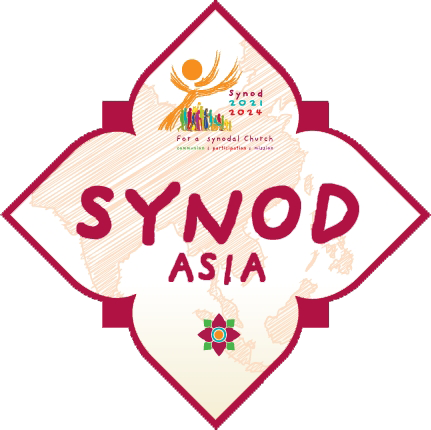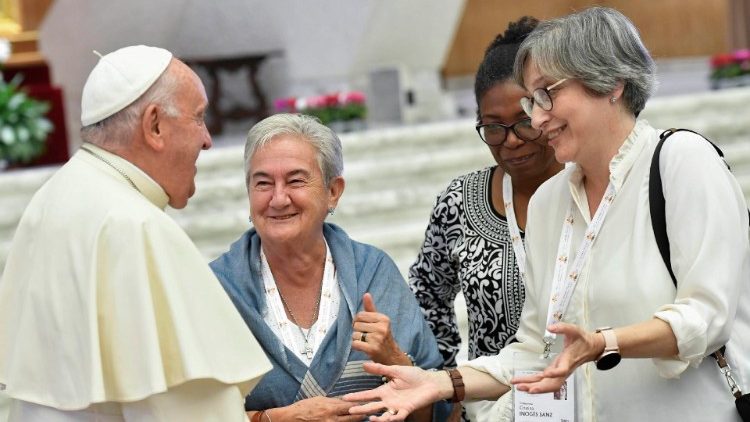Participants in the Synod General Assembly are in the Vatican’s Paul VI Hall this week are examining and discussing “Module B1”, of which we offer the full text here below.
B. Communion, mission, participation
Three priority issues for a synodal Church
“For as in one body we have many members, and not all the members have the same function, so we, who are many, are one body in Christ, and individually we are members one of another” (Rom 12: 4-5).
43. Among the fruits of the first phase, and in particular of the Continental Assemblies, which came to the fore thanks to the way of proceeding just outlined, three priorities were identified that are now proposed to the Synodal Assembly of October 2023 for discernment. These are challenges with which the whole Church must measure itself in order to take a step forward and grow in its own synodal being at all levels and from a plurality of perspectives. They need to be addressed from the point of view of theology and canon law, as well as from that of pastoral care and spirituality. They call into question the way Dioceses plan as well as the daily choices and lifestyle of each member of the People of God. They are also authentically synodal because addressing them requires walking together as a people, with all its members. The three priorities will be illustrated in connection with the three key words of the Synod: communion, mission, participation. While this is done for the sake of simplicity and clarity of presentation, it risks presenting the three key words as three “pillars” independent of one another. Instead, in the life of the synodal Church, communion, mission and participation are articulated, nourishing and supporting each other. They must always be understood with this integration in mind.
44. The different order in which the three terms appear, with mission taking the central place, is also rooted in the awareness of the links that unite that developed during the first phase. In particular, communion and mission are interwoven and mirror each other, as already taught by Saint John Paul II: “Communion and mission are profoundly connected with each other, they interpenetrate and mutually imply each other, to the point that communion represents both the source and the fruit of mission: communion gives rise to mission and mission is accomplished in communion” (CL 32, taken up in PE I,4). We are invited to move beyond a dualist understanding in which the relationships within the ecclesial community are the domain of communion, while mission concerns the momentum ad extra. The first phase has instead highlighted how communion is the condition for the credibility of proclamation, an insight which recalls that of the XV Ordinary General Assembly of the Synod of Bishops on Young People, the Faith and Vocational Discernment [1]. At the same time there is a growing awareness that the orientation for mission is the only evangelically founded criterion for the internal organisation of the Christian community, the distribution of roles and tasks, and the management of its institutions and structures. It is in relationship with communion and mission that participation can be understood, and for this reason, it can only be addressed after the other two. On the one hand, it gives them the concrete expression: attention to procedures, rules, structures and institutions allows the mission to be consolidated over time and frees communion from mere emotional spontaneity. On the other hand, it receives a meaning, orientation and dynamism that allows it to escape the risk of turning into a frenzy of individual rights claims that inevitably cause fragmentation rather than unity.
45. To accompany the preparation and structure of the work of the Assembly, five worksheets have been prepared to address each priority, to be found at the end of this section. Each of these constitutes an entry point to the priority in question which in this way can be approached from different but complementary perspectives related to different aspects of the life of the Church that have emerged through the work of the Continental Assemblies. In this case the three paragraphs that follow, to which the three groups of worksheets in the appendix correspond, should not be read as parallel and non-communicating columns. Rather, they are beams of light that illuminate the same reality, that is the synodal life of the Church, from different vantage points, continually intertwining and invoking one another, inviting us to growth.
B 1. A communion that radiates: How can we be more fully a sign and instrument of union with God and of the unity of all humanity?
46. Communion is not a sociological coming together as members of an identity group but is above all a gift of the Triune God, and at the same time a task, which is never exhausted, of building the “we” of the People of God. As the Continental Assemblies experienced, communion interweaves a vertical dimension, that Lumen gentium calls “union with God,” and a horizontal one, “the unity of all humanity”, in a strong eschatological dynamism. Communion is a journey in which we are called to grow, “until all of us come to the unity of faith and of the knowledge of the Son of God, to maturity, to the measure of the full stature of Christ” (Eph4:13).
47. We receive an anticipation of that moment in the liturgy, the place where the Church on its earthly journey experiences communion, nourishes it and builds it up. If the liturgy is in fact the “outstanding means whereby the Faithful may express in their lives, and manifest to others, the mystery of Christ and the real nature of the true Church” (SC 2) then it is to the liturgy that we must look in order to understand the synodal life of the Church. First and foremost, it is through shared liturgical action, and in particular the eucharistic celebration, that the Church experiences radical unity, expressed in the same prayer but in a diversity of languages and rites: a fundamental point in a synodal key. From this point of view, the multiplicity of rites in the one Catholic Church is an authentic blessing, to be protected and promoted, as was also experienced during the liturgies of the Continental Assemblies.
48. A synodal assembly cannot be understood as representative and legislative, analogous to a parliamentary structure with its dynamics of majority building. Rather, we are called to understand it by analogy with the liturgical assembly. Ancient tradition tells us that when a synod is celebrated it begins with the invocation of the Holy Spirit, continues with the profession of faith, and arrives at shared determinations to ensure or re-establish ecclesial communion. In a synodal assembly Christ becomes present and acts, transforms history and daily events, and gives the Spirit to guide the Church to find a consensus on how to walk together towards the Kingdom and to help all of humanity to move towards greater unity. Walking together while listening to the Word and our brothers and sisters, that is, in seeking God’s will and mutual agreement, leads to thanksgiving to the Father through the Son in the one Spirit. In a synodal assembly, those who gather in the name of Christ listen to his Word, listen to each other, discern in docility to the Spirit, proclaim what they have heard and recognise it as light for the journey of the Church.
49. In this perspective, synodal life is not a strategy for organising the Church, but the experience of being able to find a unity that embraces diversity without erasing it, because it is founded on union with God in the confession of the same faith. This dynamism possesses an impelling force that continually seeks to widen the scope of communion, but which must come to terms with the contradictions, limits and wounds of history.
50. The first priority issue that emerged from the synodal process is rooted precisely in this point. In the concreteness of our historical reality, preserving and promoting communion requires taking on the incompleteness of being able to live unity in diversity (cf. 1 Cor 12). History produces divisions, which cause wounds that need to be healed and require pathways to be forged for reconciliation. In this context, in the name of the Gospel, which bonds need to be strengthened in order to overcome trenches and fences, and which shelters and protections need to be built, and to protect whom? Which divisions are unproductive? When does graduality make the path to complete communion possible? These seem like theoretical questions, but they are rooted in the concrete daily life of Christian communities consulted in the first phase. Indeed, they concern the question of whether there are limits to our willingness to welcome people and groups, how to engage in dialogue with cultures and religions without compromising our identity, and our determination to be the voice of those on the margins and reaffirm that no one should be left behind. The five Worksheets referring to this priority try to explore these questions from five complementary perspectives.
[1] For example, at 128, the Final Document states: “[It] is not enough to have structures, if authentic relationships are not developed within them; it is actually the quality of these relationships that evangelizes”.


